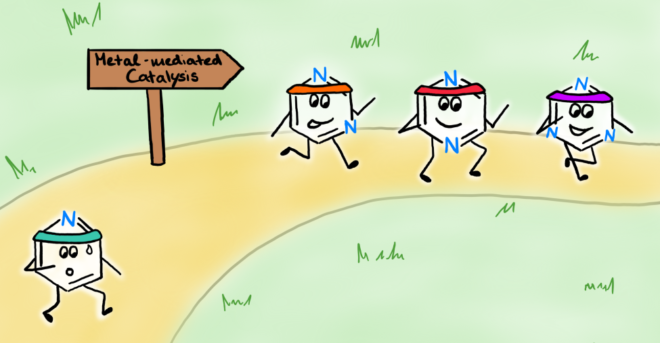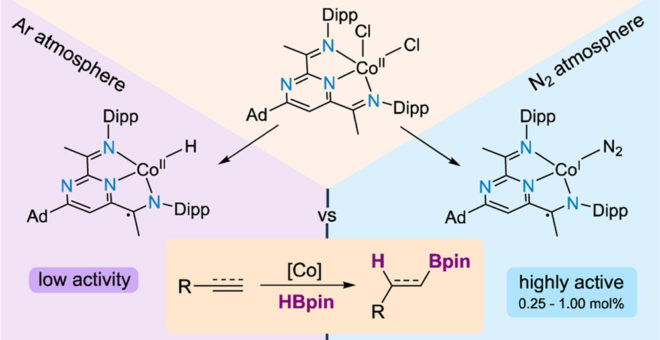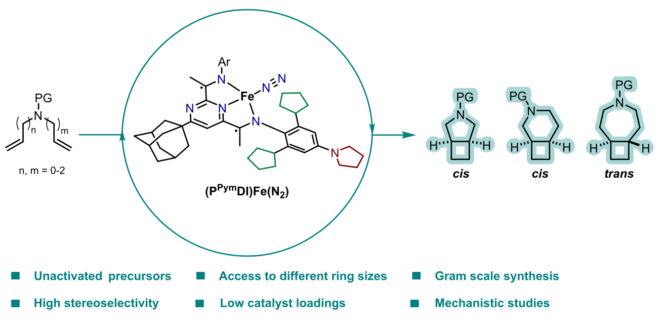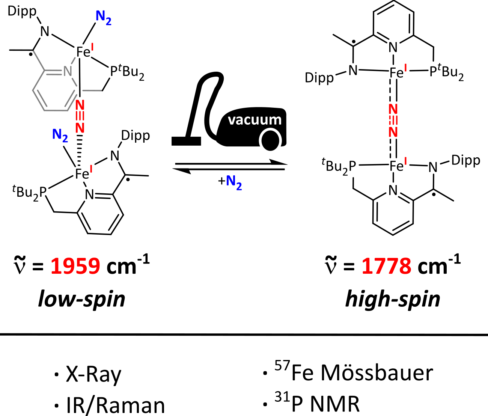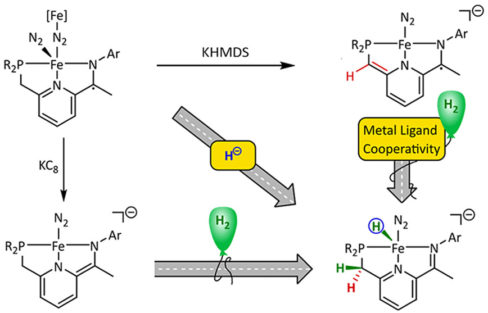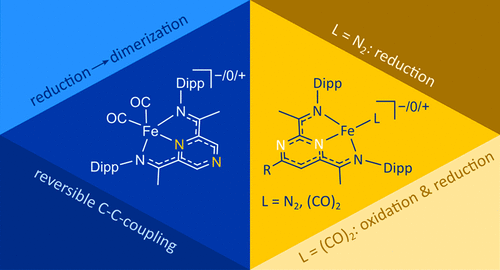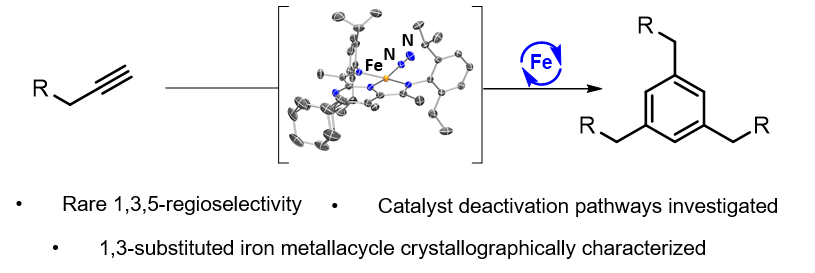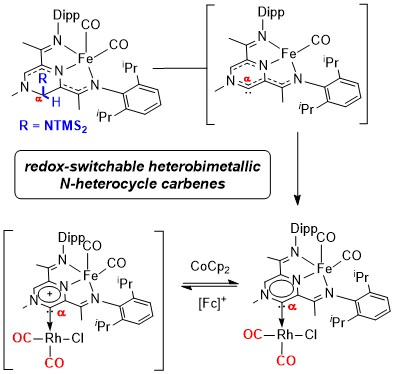
Publications
(10) Diazines and Triazines as Building Blocks in Ligands for Metal-Mediated Transformations
(9) The Atmosphere Matters: The Effect of “Inert” Gas on the Catalytic Outcomes in Cobalt-Mediated Alkyne and Olefin Hydroboration
(8) Iron-Catalyzed Synthesis of Conformationally Restricted Bicyclic N-Heterocycles via [2+2]-Cycloaddition: Exploring Ring Expansion-Mechanistic Insights and Challenges
(7) Terminal N2 Dissociation in [(PNN)Fe(N2)](µ-N2) Leads to Local Spin-State Changes and Augmented N2 Activation
(5) Metal-Ligand Cooperativity in Iron Dinitrogen Complexes: Proton Coupled Electron Transfer Disproportionation and an Anionic Fe(0)N2 Hydride
(4) Redox Activity of Iron Diazine-diimine carbonyl and dinitrogen complexes: a Comparative Study on the Influence of the Heterocyclic Ring
(3) Iron-Catalyzed Trimerization of Terminal Alkynes Enabled by Pyrimidinediimine Ligands: A Regioselective Method for the Synthesis of 1,3,5-Substituted Arenes
(2) A Redox-active Heterobimetallic N-heterocyclic Carbene based on a Bis(imino)pyrazine Ligand Scaffold
(1) Bis(imino)pyrazine-Supported Iron Complexes: Ligand-Based Redox Chemistry, Dearomatization, and Reversible C-C Bond Formation
Pre-Heidelberg Publications
(18) Site-Selective trans-Hydrostannation of 1,3- and 1,n– Diynes: Application to the Total Synthesis of Typhonosides E and F, and a Fluorinated Cerebroside Analogue.
X. Mo, A. Letort, D.-A. Roşca, K. Higashida, A. Fürstner, Chem. Eur. J., 2018, 24, 6667.
(17) Ruthenium-Catalyzed Alkyne trans-Hydrometalation: Mechanistic Insights and Preparative Implications.
D.-A. Roşca, K. Radkowski, L. M. Wolf, M. Wagh, R. Goddard, W. Thiel, A. Fürstner, J. Am. Chem. Soc., 2017, 139, 2443.
(16) Interligand Interactions Dictate the Regioselectivity of trans-Hydrometalations and Related Reactions Catalyzed by [Cp*RuCl]. Hydrogen Bonding to a Chloride Ligand as a Steering Principle in Catalysis.
S. M. Rummelt, K. Radkowski, D.-A. Roşca, A. Fürstner, J. Am. Chem. Soc., 2015, 137, 5506.
(15) Formation of Gold(III) Alkyls from Gold Alkoxide Complexes.
I. Chambrier, D.-A. Roşca, J. Fernandez –Cestau, D. L. Hughes, P. H. M. Budzelaar, M. Bochmann, Organometallics, 2017, 36, 1358.
(14) Photochemical disproportionation of an Au(II) pincer complex: Synthesis and Structure of an Au(I)Au(III) Macrocycle.
D.-A. Roşca, M. Bochmann, Organometallics, 2016, 35, 27.
(13) An element though the looking glass: Exploring the Au—C, Au—H and Au—O energy landscape.
D.-A. Roşca, J. A. Wright, M. Bochmann, Dalton Trans., 2015, 44, 20785.
(12) Gold(III)-CO and gold(III)-CO2 complexes and their role in the water-gas shift reaction.
D.-A. Roşca, J. Fernandez –Cestau, J. Morris, J. A. Wright, M. Bochmann , Science Adv., 2015, 1, e1500761.
(11) Synthesis, C—N cleavage and photoluminescence of gold(III) isocyanide complexes.
D.-A. Roşca, J. Fernandez-Cestau, A. S. Romanov, M. Bochmann, J. Organomet. Chem., 2015, 792, 117.
(10) Reactivity of Gold Hydrides: O2 insertion into the Au—H bond.
D.-A. Roşca, J. Fernandez-Cestau, D. L. Hughes, M. Bochmann, Organometallics, 2015, 34, 2098.
(9) Electrochemistry of Au(II) and Au(III) pincer complexes: determination of the AuII—AuII bond energy.
T. Dann, D.-A. Roşca, J. A. Wright, G. G. Wildgoose, M. Bochmann, Chem. Commun., 2013, 49, 10169.
(8) Gold peroxide complexes and the conversion of hydroperoxides into gold hydrides by successive oxygen-transfer reactions.
D.-A. Roşca, J. A. Wright, D. L. Hughes, M. Bochmann, Nat. Commun., 2013, 4, 2167.
(7) Gold(III) Olefin Complexes.
N. Savjani, D.-A. Roşca, M. Schormann, M. Bochmann, Angew. Chem. Int. Ed., 2013, 52, 874.
Highlight: R. Wolf, G. Clever “Trend Reports: Highlights in Inorganic Chemistry 2012”: Nachr. Chem., 2013, 61, 235.
(6) A Thermally Stable Gold(III) Hydride: Synthesis, Reactivity, and Reductive Condensation as a Route to Gold(II) Complexes.
D.-A. Roşca, D. A. Smith, D. L. Hughes, M. Bochmann, Angew. Chem. Int. Ed., 2012, 51, 10643.
(Selected as Very Important Paper) Highlighted: A. S. K. Hashmi “Fire and Ice: A Gold(III) Monohydride”: Angew. Chem. Int. Ed, 2012, 51, 12935.
and R. Wolf, G. Clever “Trend Reports: Highlights in Inorganic Chemistry 2012”: Nachr. Chem., 2013, 61, 235.
(5) Selective Au−C Cleavage in (C∧N∧C)Au(III) Aryl and Alkyl Pincer Complexes.
D. A. Smith, D.-A. Roşca, M. Bochmann, Organometallics, 2012, 31, 5998.
(4) Cyclometallated Gold(III) Hydroxides as Versatile Synthons for Au-N, Au-C Complexes and Luminescent Compounds.
D.-A. Roşca, D. A. Smith, M. Bochmann, Chem. Commun., 2012, 48, 7247.
(3) New Diorganoselenium(II) Compounds and Their Behaviour Towards Late Transition Metals.
A. Pop, D.-A. Roşca, R. Mitea, A. Silvestru, Inorg. Chim. Acta., 2013, 405, 235.
(2) Alkali aminoether-phenolate complexes: Synthesis, structural characterization and evidences for an activated monomer ROP mechanism.
S.-C. Roșca, D.-A. Roşca, V. Dorcet, C. M. Kozak, F. Kerton, J.-F. Carpentier, Y. Sarazin, Dalton Trans., 2013, 42, 9361.
(1) Bis(dimethylsilyl)amide Complexes of the Alkaline-Earth Metals Stabilized by β-Si-H Agostic Interactions: Synthesis, Characterization, and Catalytic Activity.
Y. Sarazin, D.-A. Roşca, V. Porier, T. Roisnel, A. Silvestru, L. Maron, J.-F. Carpentier, Organometallics, 2010, 29, 6569.


